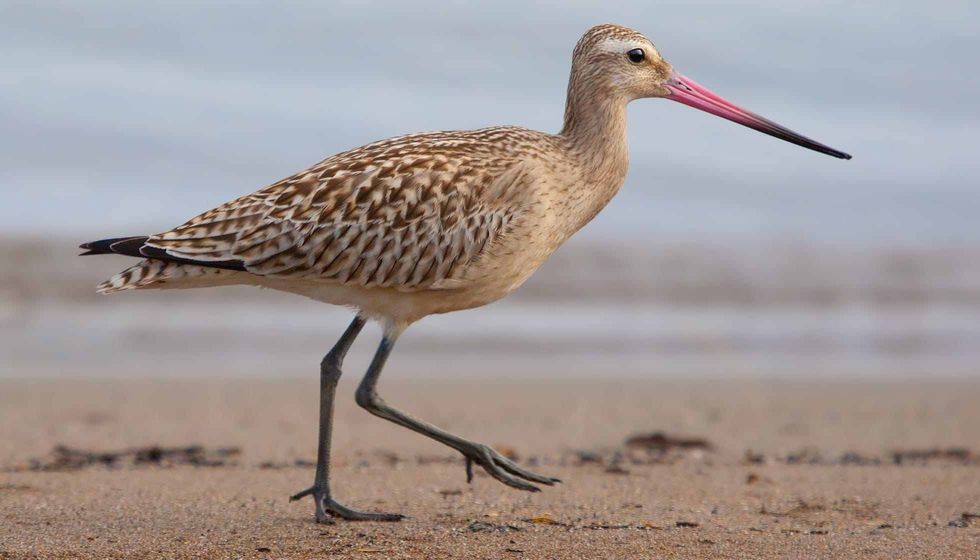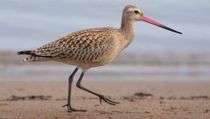There are several interesting facts about the bar-tailed godwit (Limosa lapponica) for kids to learn. Let us start with the class, order, family, genus, and kingdom of these birds.
They belong to the kingdom Animalia, class Aves, order Charadriiformes, family Scolopacidae, and genus Limosa. The bar-tailed godwit is a migratory bird and they spend the summers in Alaska and Scandinavia mostly. However, during the winter, they migrate from Alaska to the Southern Hemisphere and settle in places like New Zealand and Australia.
Both their breeding and non-breeding population has a conservation status of Near Threatened. This means they face the danger of extinction in the future. Wondering what makes bar-tailed godwits endangered?
They face threats of habitat loss. Currently, their population is not widespread across the globe and is declining.
Keep on reading to know more about their behavior patterns along with other fun facts about the bar-tailed godwit. For more similar content, check out godwit and marbled godwit.
Bar-Tailed Godwit Interesting Facts
What type of animal is a bar-tailed godwit?
The bar-tailed godwit is a type of bird.
What class of animal does a bar-tailed godwit belong to?
The bar-tailed godwit belongs to the class Aves.
How many bar-tailed godwits are there in the world?
The current estimate of the global population of bar-tailed godwits stands at 1,099,000–1,149,000. The population of these birds is on the decline. From 2005-2012, there has been a steep downfall in their population. Studies show that this decline is due to the loss of staging areas between tides in the Yellow Sea.
Where does a bar-tailed godwit live?
Bar-tailed godwits are birds of migration. Their breeding range varies from their non-breeding or winter range.
Their breeding range comprises the shores along the Arctic Ocean and these shores range from Alaska to Scandinavia. On the other hand, they spend the winter season in New Zealand, parts of the Old World, and Australia.
While flying for migration, these birds fly over the Pacific Ocean. This flight of migration is not only long-distance, but it is also a non-stop flight. The non-stop migration flight of bar-tailed godwits is the longest one seen in any bird species.
They do not even stop to feed in between the migration process. The migration trip from their summer to winter range and back is about 18,020 mi (29,000 km).
What is a bar-tailed godwit's habitat?
Bar-tailed godwits have a natural habitat of mangroves, estuaries, shores, and mudflats. During the summer season, they can be found in tundra plains, shrubs, and grounds with hummocky slopes. Owing to migration during the winter months, the winter habitat mostly comprises mudflats such as lakes, estuaries, and bays.
Who do bar-tailed godwits live with?
The bar-tailed godwit is a social bird and they can be seen forming groups or flocks with other birds of their own kind. They can also be seen with other birds.
How long does a bar-tailed godwit live?
Bar-tailed godwits have quite an extensive lifespan. On average, they can live up to as many as 34 years.
How do they reproduce?
The bar-tailed godwit bird achieves its sexual maturity at the age of two to four years. It is during this time that the bird takes flight for the summer range from their winter range. These birds build their nest using plants and moss.
The nest usually takes the form of a cup with a shallow depth. The female lays two to five eggs in this nest. Both the male and the female parents incubate the eggs.
The female takes her turn to incubate during the day, and the male takes charge during the nighttime. Incubation of the eggs requires 20-21 days. Following this, young ones hatch from the eggs.
What is their conservation status?
As per the International Union for Conservation of Nature (IUCN) Red List, these birds fall under the category of Near Threatened. Their population faces the threat of extinction in the future as it is decreasing by the day.
Bar-Tailed Godwit Fun Facts
What do bar-tailed godwits look like?
The adult bar-tailed godwit has long limbs which are bluish-gray in color. Their beak is upturned and tapered, and has a pink base and the tip is black.
The breeding plumage is different from their winter plumage. The breeding plumage has brown feathers on the back with brownish-red feathers under the belly, neck, and breast. The winter plumage is grayish-brown.
How cute are they?
This bird is quite cute to look at, just like storks. Their slender bodies with long bills add to their good looks.
How do they communicate?
These birds have a minimum of five calls that they give out on breeding grounds. Most of these calls on their breeding grounds comprise songs, breeding or mating calls, and rapid calls. They also have something called the nest-scraping call which is given out by a male who is in courtship while he scrapes the ground for nesting materials.
How big is a bar-tailed godwit?
The bar-tailed godwit is 15–16 in (37–41 cm) in length. They are somewhat smaller in size than the marbled godwit which is 16-20 in (41-51 cm), in length.
How fast can a bar-tailed godwit move?
Records show that the quickest flight speed of a bar-tailed godwit has been 55 mph (88.5 kph).
How much does a bar-tailed godwit weigh?
Female godwits weigh slightly more than the males. While females weigh 9.2–22.2 oz (260–630 g), males have a weight of about 6.7–14.1 oz (190–400 g). They are bulkier than sparrowhawks.
What are the male and female names of the species?
The male bird is called a cock, while the female bird is called a hen.
What would you call a baby bar-tailed godwit?
A baby bird is called a chick.
What do they eat?
They are omnivorous animals, unlike northern goshawks. They feed on seeds and berries like most other birds. Apart from seeds and berries, they also feed on mollusks, aquatic insects, worms, and crustaceans.
Are they dangerous?
No, these birds are not dangerous.
Would they make a good pet?
Although they are harmless, the bar-tailed godwit is a wading bird of large stature. They do not make ideal pets, just like hawks. Also, they are migratory birds by nature so it is not right to keep these birds in captivity.
Did you know...
Winters in Alaska get too severe for the bar-tailed godwit to survive. They store fat in their body and change their breeding plumage to winter plumage, as well as migrate down south to warmer climates.
What are the different types of godwits found?
There are four types of godwits. Apart from the bar-tailed godwit, there is the Hudsonian godwit, the black-tailed godwit, and the marbled godwit.
The godwit got its name from the sound that the bird used to make. Another theory states that the name is derived from the words 'god' and 'whit' which means 'good creature' in Old English.
Where do bar-tailed godwits migrate to?
Bar-tailed godwits spend the summer months in the Northern Hemisphere, along the Pacific and Arctic shores like Alaska and Scandinavia. They fly to the Southern Hemisphere in winter in search for warmer climates. Their winter range includes places like the Yellow Sea, New Zealand, parts of the Old World, and Australia.
Here at Kidadl, we have carefully created lots of interesting family-friendly animal facts for everyone to discover! For more relatable content, check out these limpkin facts and jack snipe facts for kids.
You can even occupy yourself at home by coloring in one of our free printable bar-tailed godwit coloring pages.









